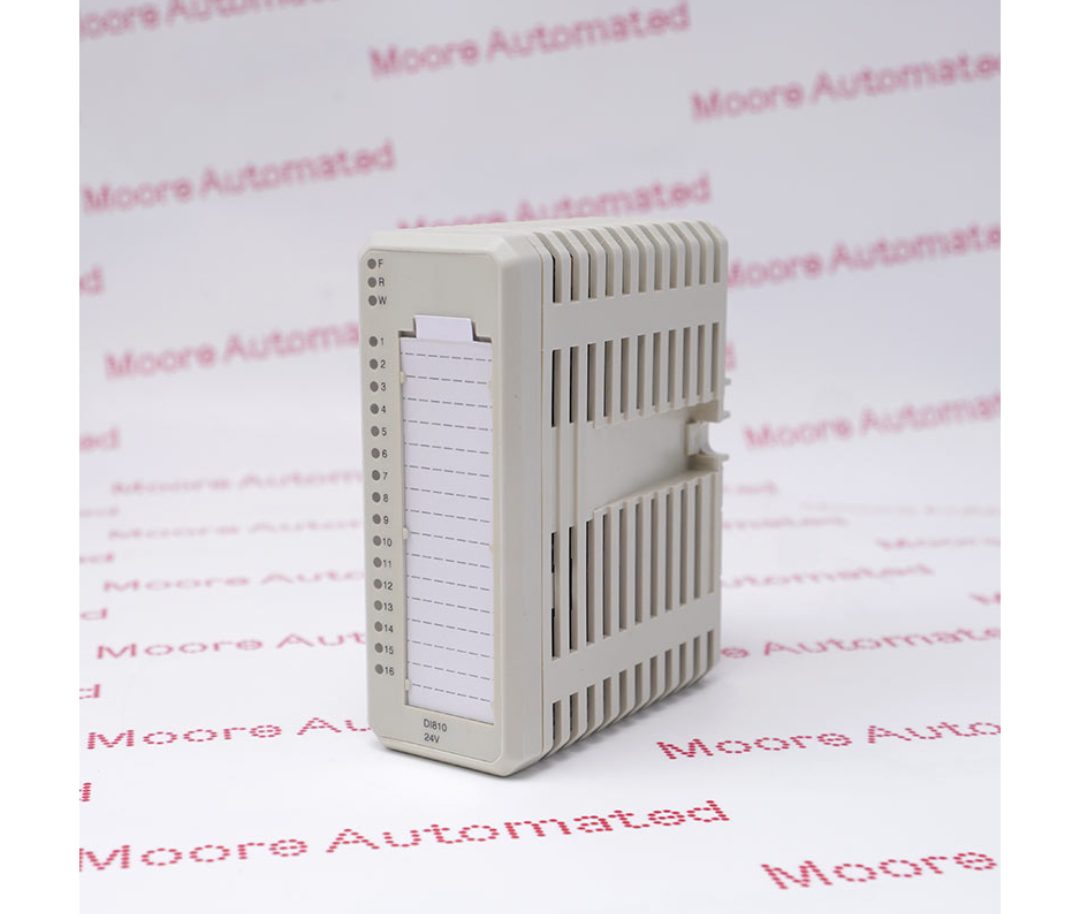Automation projects routinely exceed budgets due to unforeseen component costs, with industrial control modules being frequent culprits. The DI810 3BSE008508R1 digital input module, a workhorse in ABB’s AC 800M distributed control systems, exemplifies this challenge. Despite its critical role in monitoring field signals across manufacturing, energy, and process industries, many engineers underestimate how price fluctuations and technical complications can derail financial planning. A single module replacement during commissioning might cost three times the budgeted amount due to market volatility, while improper installation can trigger cascading failures requiring emergency procurement.
This article reveals practical strategies to neutralize these risks through intelligent supplier relationships, proactive inventory tactics, and technical best practices. By understanding the DI810’s operational context and implementing cost-stabilization measures, project managers can transform this essential component from a budget wildcard into a predictable line item, ensuring both fiscal discipline and system reliability throughout the project lifecycle.
Understanding the DI810 3BSE008508R1: Core Features and Industrial Role
Input/output modules serve as the sensory network of automation systems, translating field-level signals into actionable data for programmable logic controllers. The DI810 3BSE008508R1 digital input module operates within ABB’s AC 800M architecture, processing 24V DC signals across 16 isolated channels with millisecond-level response times. Its galvanic isolation protects control systems from electrical noise in harsh industrial environments, while integrated diagnostics continuously monitor channel health and wiring integrity. Unlike commodity I/O devices, this module meets stringent safety standards for applications like emergency shutdown systems in chemical plants and turbine monitoring in power generation facilities.
The module’s hot-swappable design allows maintenance without system shutdowns, critical for continuous process industries where downtime costs exceed thousands per minute. Its compatibility with redundant controller configurations ensures uninterrupted operation during hardware failures. While generic alternatives may offer lower upfront costs, the DI810’s proven reliability in safety-instrumented systems and seamless integration with distributed control infrastructure justifies its position as a standard component in mission-critical automation projects where signal accuracy and system availability directly impact operational safety and production continuity.
Price Volatility Challenges in Automation Components
Industrial control components experience price swings that dwarf typical electronic commodity fluctuations, driven by factors unique to specialized manufacturing. Global semiconductor shortages routinely double lead times for modules like the DI810, forcing distributors to implement surge pricing when inventory dwindles. Obsolescence cycles compound this issue—as ABB phases production toward newer architectures, remaining stock commands premium pricing while aftermarket suppliers exploit scarcity. Currency fluctuations further destabilize costs when modules manufactured in Europe reach projects in dollar-denominated markets. These dynamics create budgeting chaos for multi-year automation projects where initial quotes become obsolete before purchase orders finalize. A European refinery expansion project illustrates the risk: engineers budgeted for twenty DI810 modules at standard catalog rates, but supply chain disruptions during construction pushed replacement costs up 140 percent when three modules failed commissioning tests.
The unplanned $8,400 expenditure triggered budget reallocation from operator training programs, ultimately delaying project handover by six weeks. Effective procurement planning now requires treating automation components as volatile assets rather than fixed costs, incorporating price escalation clauses in contracts and maintaining financial buffers equivalent to 25-30 percent of critical component budgets to absorb market shocks without compromising project timelines or scope.
Proactive Strategies for DI810 Price Stability
Supplier Negotiation Tactics
Establishing multi-year agreements with authorized ABB distributors creates pricing predictability that shields projects from market turbulence. These contracts typically lock base prices for 12-24 months with predetermined escalation caps, often limiting increases to 5-8 percent annually regardless of broader market conditions. Negotiating volume commitments across multiple projects amplifies leverage—a facilities manager consolidating DI810 purchases for three simultaneous plant upgrades secured 18 percent discounts by guaranteeing minimum order quantities.
The key lies in timing negotiations during supplier fiscal planning periods when distributors prioritize revenue forecasting over margin maximization. Request tiered pricing structures that reward incremental purchases, such as reduced rates when orders exceed ten modules quarterly. Include contractual provisions for price-match guarantees against competing authorized distributors, forcing suppliers to honor lowest available market rates.
For organizations with limited purchasing power, joining procurement consortiums with industry peers pools buying volume to access enterprise-level pricing previously reserved for multinational corporations, transforming individual buyers into collective negotiating forces. Specialized PLC suppliers like Moore Automation often maintain consistent pricing structures for industrial control components, making them valuable partners for comparative pricing analysis during contract negotiations.

Inventory Management Solutions
Strategic spare module stockpiling balances cost avoidance against capital immobilization by aligning inventory levels with system criticality and failure probability. Calculate optimal stock quantities using the formula: (Annual module count × Historical failure rate) + (Lead time in months ÷ 12 × Monthly usage rate). For a facility operating 80 DI810 modules with 3 percent annual failure rates and 16-week supplier lead times, this yields five spare units—enough to cover typical failures without tying up excessive working capital. Time bulk purchases to coincide with ABB product lifecycle announcements, acquiring discounted inventory before migration to next-generation platforms triggers price premiums on legacy components.
Monitor end-of-life notices through distributor alerts and technical bulletins, purchasing 5-7 year supply reserves when discontinuation appears imminent. Implement consignment inventory arrangements where distributors maintain on-site stock with payment triggered only upon module deployment, eliminating upfront capital requirements while ensuring immediate availability. Rotate stored modules into active service every 18 months to prevent shelf-life degradation while maintaining fresh backup inventory, creating a self-replenishing buffer that costs nothing beyond initial procurement.
Technical Support Systems for Rapid Issue Resolution
Minimizing downtime costs requires establishing support infrastructure before failures occur, transforming reactive troubleshooting into systematic problem resolution. ABB’s Library documentation portal provides DI810-specific resources including wiring diagrams, diagnostic flowcharts, and firmware compatibility matrices accessible through registered user accounts—investing two hours in team training on this portal reduces average troubleshooting time from four hours to thirty minutes. Formalize vendor relationships through service-level agreements that guarantee response times, with premium tiers offering 24/7 phone support and four-hour on-site assistance for critical failures.
A Midwest automotive plant demonstrated this value when a midnight production line stoppage triggered by faulty DI810 diagnostics received remote support within twelve minutes, identifying a loose terminal connection that maintenance resolved in eight minutes—avoiding $47,000 in lost production. The module’s tri-color LED indicators provide real-time status feedback: green confirms normal operation, yellow signals communication errors requiring network cable inspection, and red indicates power supply failures or channel faults.
Train technicians to interpret these patterns during routine rounds, catching intermittent issues before they escalate into emergency shutdowns. Maintain a digital logbook documenting all DI810 anomalies with timestamps and resolutions, creating institutional knowledge that accelerates future diagnostics and identifies recurring failure modes requiring design modifications or environmental corrections.
Installation Best Practices to Avoid Costly Errors
Proper DI810 installation eliminates 80 percent of field failures that trigger emergency replacements and system downtime. Begin by verifying power supply voltage stability within the 19.2-30V DC range using a calibrated multimeter, as voltage sags below threshold cause intermittent communication errors that mimic module defects. Route signal cables separately from high-voltage motor leads, maintaining minimum 300mm separation to prevent electromagnetic interference that corrupts input readings. Secure all terminal connections to 0.5-0.6 Nm torque specifications using calibrated drivers—loose connections create resistive heating that degrades terminals over months, eventually causing complete channel failure. Mount modules in climate-controlled enclosures maintaining 0-60°C ambient temperatures with relative humidity below 95 percent non-condensing, as moisture ingress corrodes circuit boards despite conformal coating protection.
Conduct loop checks before energizing the system by injecting test signals at field devices while monitoring controller response, verifying each of the sixteen channels registers state changes within specification. Establish quarterly inspection schedules where technicians check terminal tightness, clean ventilation slots, and verify LED status patterns, catching degradation before catastrophic failures occur. This disciplined approach transforms installation from a rushed commissioning task into a reliability foundation that protects both module investment and operational continuity.
Implementing Cost Control for Long-Term Success
The DI810 3BSE008508R1 digital input module remains indispensable for safety-critical automation systems, yet its cost predictability hinges on three interconnected management pillars. Price stability emerges through disciplined supplier negotiations that lock multi-year rates and strategic inventory positioning timed to lifecycle transitions, transforming volatile market conditions into controlled expenditures. Responsive technical support infrastructure—whether through formalized vendor service agreements or internal diagnostic competency—converts potential emergency replacements into planned maintenance activities, slashing downtime expenses. Installation rigor and preventative care eliminate the majority of premature failures that trigger unbudgeted procurement cycles.
Organizations that continue reactive purchasing and ad-hoc troubleshooting will repeatedly face cost overruns averaging 30-50 percent above baseline budgets. Begin immediately by auditing current DI810 suppliers against criteria including contract flexibility, technical support response metrics, and lifecycle transparency. Develop a vendor scorecard evaluating price consistency over twelve-month periods, support resolution times, and inventory availability guarantees. This systematic approach transforms the DI810 from a budget risk into a manageable asset, ensuring both financial control and operational reliability across the project’s complete lifecycle.




























